A Private Autumn single day tour in North Norfolk today. It was mostly cloudy today but mostly dry – we managed to largely dodge the showers, particularly in the afternoon. A brisk NE wind held lots of promise for migrants coming in from the continent.
Our first destination for the morning was Wells. Walking in towards the woods from the beach car park, we could see several Little Grebes on the Boating Lake as usual and a few Coot and Mallard to get the day’s list started.

As soon as we got into the birches, we found our first tit flock. There were lots of birds flitting around in the trees overhead – Long-tailed Tits, Blue and Coal Tit, Goldcrests and a Treecreeper. Small groups of Redwings flew back and forth overhead and we could hear their teezing calls.
Walking round the north side of the Dell, we flushed more Redwings and several Blackbirds from the bottom, under the trees. We cut across the middle, over the main track and out into the more open area the other side. There were loads of Redwings here too, feeding on berries in the bushes and out on the grass on the grazing marshes beyond. Looking through them, we managed to find one or two Song Thrushes as well. There had clearly been a big arrival of thrushes here in the last 24 hours, mainly Redwings, coming here from Scandinavia for the winter.

A couple of Marsh Harriers were flying round over the grazing marshes beyond, a juvenile with bright red wing tags (unfortunately too far away to read the identifying code), and an adult female with much more pale creamy colouring on the leading edge of the wings. Two Red Kites were hanging in the air over the trees in the Park at the back.
The Marsh Harriers kept flushing all the ducks from the grazing marshes, the flocks Wigeon and Teal flying round before settling again around the pools. There were a few Curlew and Lapwing, and several Pied Wagtails out on the wet grass too.
Small groups of Redpolls kept flying back and forth overhead calling while we were scanning the grazing marshes and as we walked on a little further a few flew in and landed in the top of a large birch tree in front of us. We had a much better view of them now, and got one or two in the scope, admiring the red ‘polls’ on their foreheads and black chin patches. These birds looked rather small and brown, Lesser Redpolls. More dropped in to join them and others flew out – there was lots of coming and going.

Continuing round, two Sparrowhawks were up over the pines in the distance, chased by two Carrion Crows, swooping in and out of the treetops. Two male Blackcaps popped up in the top of a large clump of Hawthorn and briar.
Back out on the main track, there were lots of Goldcrests in the birches, as we caught the tail end of another tit flock as it disappeared into the pines. There was nothing of note in the bushes round the Drinking Pool but a couple of Bramblings were calling in the pines and we had a fleeting view high in the trees and then saw one of them flying off.
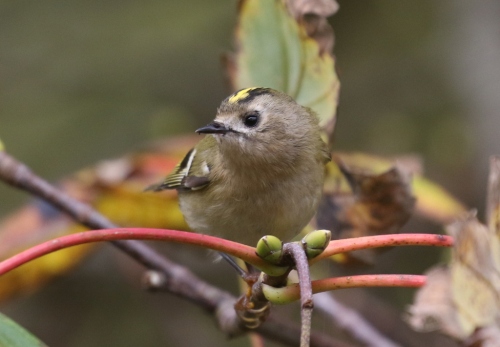
Continuing west on the main track, we stopped to watch some more Goldcrests feeding in some sycamores right by the path. We had some great views of them, down at eye level. While they do breed here, numbers are swollen in autumn by arrivals from the continent. We marvelled at how these tiny birds weighing no more than a 20p coin, can manage to fly all the way across the North Sea. When they arrive they are not surprisingly exhausted and hungry and therefore very confiding.
We were just in the process of discussing how you might tell a Firecrest from a Goldcrest when we had a shout from a friend deeper in the trees in front of us that he had just found one! It was very active, flitting around in the oaks, and hard to see. We had a few quick glimpses and then lost track of it. While we were looking round in the trees for the Firecrest, a Yellow-browed Warbler appeared too, but again we only managed frustratingly brief views of it before we lost track of it.
The Goldcrests seemed to be working their way slowly east through the trees, so we walked back out onto the track and followed them. We could hear more wheezy calls from Bramblings a little further along and walked back where a smart male finally gave itself up nicely in some birches, turning round and showing off its bright orange breast and shoulders.

There were no Goldcrests this far down – we seemed to have overshot the flock – so we walked back a few metres until we found them again. Suddenly out popped a boldly marked head low in an oak tree right in front of us, like a rather like Goldcrest but with additional stripes, black through the eye and a striking white supercilium above. It was the Firecrest and we had great views of it now as it performed in front of our eyes.

We continued to follow the Goldcrests and we were rewarded again when the Yellow-browed Warbler reappeared in a small sycamore beside the track. It fed here for a couple of minutes now, giving us the chance to get a better look at its stripes, a striking yellowish supercilium and double wing bars.
Having enjoyed great views of Firecrest and Yellow-browed Warbler, we decided to start walking back. There was a report of some other birds in the open area by the Dell now, so we cut back in and walked slowly in through the grass and round the brambles and hawthorns.
A Lesser Whitethroat flicked out ahead of us, and we watched it feeding in the brambles. At this time of year, they are mainly ‘Eastern’ Lesser Whitethroats passing through, birds of the race blythi, also known as Siberian Lesser Whitethroats and coming to us from much further east. Sure enough, this was an Eastern Lesser Whitethroat, with the brown of the mantle continuing as a shawl up over the back of the head. We could hear its quiet tacking calls as it worked its way round.
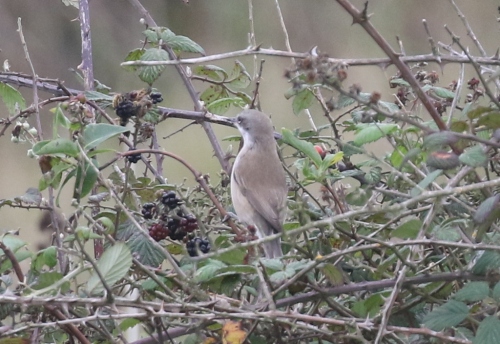
We found a smart male Bullfinch in the brambles too, and still lots of Redwings and Redpolls, but no sign of the Redstart now which was seen here earlier. As we made our way back to the main track, a couple of Redpolls flew in and landed briefly in the hawthorns ahead of us. A flash of a streaky but pale rump on one indicated it was a Mealy Redpoll, the flammea race of Common Redpoll which comes here from Scandinavia in the autumn.
Cutting back in round the east side of the Dell, we had another look in the birches on our way back to the car park. Several Blackcaps flitted ahead of us and a couple of Bullfinches were in the brambles. There was a tit flock in the trees here again, the light was better this time. We spent some time looking through them – lots of Goldcrests but nothing more unusual.
Back out to the car park, we picked up lunch and walked over to the harbour. Up on the seawall, we ate our lunch while we scanned the channel and the mud and sands opposite. There were a few Cormorants diving in the channel itself and a couple of closer Brent Geese on the far side. We could see lots more Brent Geese further out on the sands and they started to fly back in past us and back into the harbour, presumably to feed.
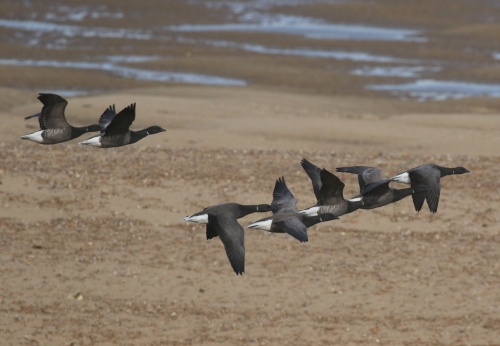
The waders were rather distant at first here today, right up on the back of the mud towards East Hills. Through the scope, we could see lots of Knot, together with several Dunlin and Turnstones. A couple of Ringed Plover were well camouflaged on one of the patches of shingle. There was a scattering of Curlew and a good number of Oystercatchers here too.
A dark shape hunched right out on the middle of the sands, as we thought it might, resolved itself into a Peregrine through the scope, loafing out on a sand bar. Presumably it had been hunting the waders and had stopped for a rest.
So when something flushed all the Knot, we thought at first the Peregrine might be the culprit, but it was still on the sand in the same place. We watched as the Knot whirled round in a tight flock, back and forth, twisting and turning, flashing grey and white. Four larger birds with them were Bar-tailed Godwits. All of them landed together on the edge of the channel, giving us a much better view, the godwits squabbling in the shallow water.
We stopped at the beach cafe for a welcome hot drink. We had a few possible options for the afternoon, but there had been a small number of Pallas’s Warblers appearing along the coast this morning and we thought we would try for the one which had been reported already several times, out at Burnham Overy Dunes. We parked in the car park at the staithe, and walked out along the seawall, hoping to pick up a few waders en route.
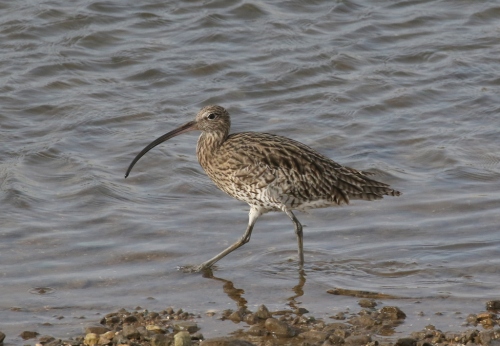
A close Curlew was feeding down on the near edge of the harbour channel as we set off and more were out on the grazing meadows the other side. Our attention was caught by three Moorhen just beyond the ditch. Two seemed to be fighting, one pinned down by the other, while the third looked on. When the fighting birds separated, one tried to run off but was chased all the way along the bank by the other, pecking at its heels. The third ran along too a few seconds later, not wanting to be left behind.
There were a couple of Grey Plovers down beside the harbour channel further along and two Ringed Plovers out on the sandbank in the middle, along with a few Brent Geese and Wigeon. Looking out over the saltmarsh beyond, we could see a few white shapes, which were all Little Egrets.
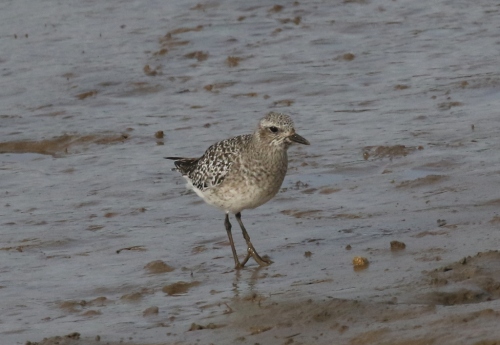
Past the corner on the seawall, there were lots of Dunlin on the open muddy inlet, along with a couple more Ringed Plover, and lots of Redshanks too. A Stonechat perched up briefly on the brambles.
The cattle were rather distant today, out in the middle of the grazing marshes looking over towards Holkham. We did see a few white birds flying round amongst them, at least three Cattle Egrets, but they kept landing out of view behind a line of reeds. The large flock of Golden Plover out on the saltmarsh was very well camouflaged against the other burnt colours of autumn vegetation.
When we got out to the boardwalk, we turned west to walk out to Gun Hill. We had already been told that the Pallas’s Warbler had not been seen again, for at least the last couple of hours, but we thought we should try our luck anyway. We flushed yet more Redwings from the bushes on the way and there were more Goldcrests in the low privet and bramble out in the dunes. The Goldcrests were unbelievably tame – just arrived over the North Sea, exhausted, they simply have to feed and have no time to worry about people. Despite our best efforts, we couldn’t find any sign of the Pallas’s Warbler here.
We climbed up onto the higher dunes to look out over the beach. There were lots of Cormorants drying their wings on the sandbank at the entrance to the channel, and a single Sanderling running along the shoreline nearby.
After a sit down, it was time to start walking back. We had a better view of the Cattle Egrets on the return journey. We got a couple in the scope, feeding in between the legs of the cows, and managed to count at least seven out there now. They were still rather distant though, out on the grazing marshes.
As we drove back east, we stopped briefly at Holkham. There were lots of Cormorants loafing in the trees, presumably getting ready to roost. The first Great White Egret was out on a small pool on the grazing marsh. Then we found a second in with the Belted Galloway cows along with a Grey Heron (they probably had an identity crisis and thought they were Cattle Egrets too!). A third Great White Egret appeared further back, and with a bit of careful scanning we found a fourth away in the distance.

That would have been more than enough, but what may have been a fifth Great White Egret flew in just as we were packing up. This is another species which has colonised in a remarkably short space of time, and gone from being rare to not uncommon now. A couple of Marsh Harriers were circling over the near edge of the marshes, presumably getting ready to go to roost. Unfortunately it was time for us to call it a day too.
















